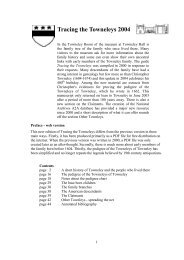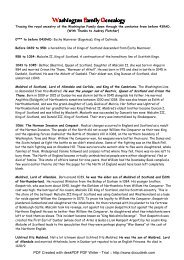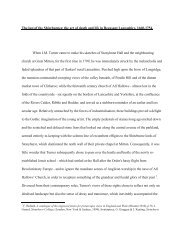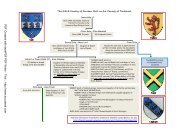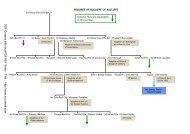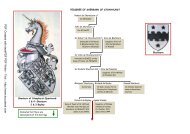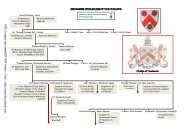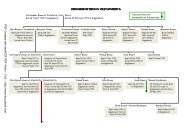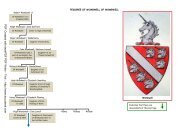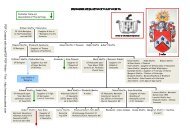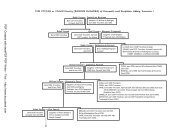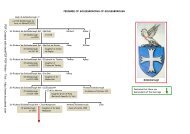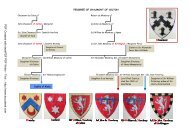Shafto Robert (1732-97).pdf - Ingilby History
Shafto Robert (1732-97).pdf - Ingilby History
Shafto Robert (1732-97).pdf - Ingilby History
Create successful ePaper yourself
Turn your PDF publications into a flip-book with our unique Google optimized e-Paper software.
<strong>Shafto</strong>, <strong>Robert</strong> (c.<strong>1732</strong>–17<strong>97</strong>), landowner and politician, was the eldest of the four children<br />
of John <strong>Shafto</strong> (d. 1742) of Whitworth, co. Durham, and his wife, Mary (d. 1768), daughter<br />
of Thomas Jackson of Nunnington, Yorkshire. The <strong>Shafto</strong> family estate at Whitworth, co.<br />
Durham, was inherited by <strong>Shafto</strong>'s father in 1729 upon the death of his elder brother,<br />
<strong>Robert</strong>. It is not known exactly when or where <strong>Shafto</strong> was born, but he probably spent most<br />
of his childhood at Whitworth, living in the manor house which <strong>Robert</strong> Surtees described as<br />
‘one of the best family mansions in the county’ (Surtees, 3.302). The property had been<br />
owned by the <strong>Shafto</strong> family since 1652, when it was bought by <strong>Shafto</strong>'s great-greatgrandfather,<br />
Mark <strong>Shafto</strong>, a barrister and, from 1648, recorder of Newcastle upon Tyne.<br />
<strong>Shafto</strong> was educated at Westminster School, London, from 1740 to 1749, and at Balliol<br />
College, Oxford, where he matriculated on 10 November 1749. He succeeded to the family<br />
estate on his father's death, 3 April 1742. <strong>Shafto</strong>'s role in public life would follow the<br />
examples of the careers of his uncle, <strong>Robert</strong> (d. 1729), and his father, both of whom were<br />
MP for the city of Durham, from 1712 to 1713 and 1727 to 1729, and from 1729 to 1742<br />
respectively. <strong>Shafto</strong>'s political career began in 1760, when he defeated the ‘regular Whig’<br />
(Namier, ‘<strong>Shafto</strong>, <strong>Robert</strong>’, 427) Thomas Clavering to be elected MP for Durham county. He<br />
was put up for election by Henry Vane, first earl of Darlington, and his campaign was<br />
supported by the bishop of Durham and Thomas Pelham-Holles, duke of Newcastle. <strong>Shafto</strong>'s<br />
uncle and father had been tories, and once in the Commons he abandoned his patron<br />
Newcastle and, like many other former tories, allied himself with the followers of John<br />
Stuart, third earl of Bute. In 1767 he was recorded as a supporter of the Chatham<br />
administration. He remained MP for Durham until 1768, when he declined to stand for reelection.<br />
<strong>Shafto</strong> married Anne Duncombe (d. 1783), daughter and heir of Thomas Duncombe of<br />
Duncombe Park, Yorkshire, on 18 April 1774 at her uncle's house in Grosvenor Square,<br />
London. The ceremony was conducted by <strong>Shafto</strong>'s brother, Thomas Goodfellow <strong>Shafto</strong>, who<br />
was the rector of St Brandon's church, Brancepeth, co. Durham. <strong>Shafto</strong> and his wife had<br />
three children, John (1775–1802), <strong>Robert</strong> (1776–1848), and Thomas (b. 1777).<br />
<strong>Shafto</strong> was MP for Downton, Wiltshire, from 1780 to 1784, and from 1784 to 1790. His<br />
wife, Anne, had inherited property at Downton, and while John Robinson wrote in 1783 that<br />
Downton was ‘Mr <strong>Shafto</strong>'s borough. He will come in himself. Attention and civility may<br />
probably obtain the other seat’ (Namier, ‘<strong>Shafto</strong>, <strong>Robert</strong>’, 427), the 1784 election was<br />
actually contested by candidates supported by Jacob Pleydell-Bouverie, second earl of<br />
Radnor, who was a coheir of the Duncombe property. <strong>Shafto</strong> was re-elected, but only after<br />
the Commons had to decide the merits of rival ballots run by the <strong>Shafto</strong> and Radnor<br />
factions. Namier commented that <strong>Shafto</strong> ‘is not known to have spoken in the House’ (ibid.)<br />
during his time as MP for Downton; although usually in opposition, he voted with William Pitt<br />
the younger during the regency crisis of 1788–9. He did not seek re-election in 1790.<br />
<strong>Shafto</strong> is remembered as the subject of the popular song ‘Bonny Bobby <strong>Shafto</strong>’. The song<br />
was probably written in the eighteenth century, although various additional verses were<br />
probably written later. Sir Cuthbert Sharp observed that, as a young man, <strong>Robert</strong> <strong>Shafto</strong><br />
was ‘popularly called “Bonny Bobby <strong>Shafto</strong>e”’ (Sharp, 55). Sharp proceeded to state that the<br />
PDF Created with deskPDF PDF Writer - Trial :: http://www.docudesk.com
song was used for ‘electioneering purposes in 1761, when <strong>Robert</strong> <strong>Shafto</strong>, of Whitworth, Esq.,<br />
was the favourite candidate’ (ibid.). He particularly refers here to the verse beginning:<br />
Bobby <strong>Shafto</strong>'s looking out,<br />
All the ribbons flew about<br />
and says that the first two verses (which begin ‘Bobby <strong>Shafto</strong>'s gone to sea’ and ‘Bobby<br />
<strong>Shafto</strong> bright and fair’) ‘are the most ancient’ (ibid.). The song confusingly, however, tells of<br />
a Bobby <strong>Shafto</strong> who has ‘gone to sea’, promising to marry the girl he has left behind on his<br />
return. Sharp recounts how a ‘Miss Bellayse, the heiress of Brancepeth’ was believed to<br />
have ‘died for the love’ (ibid.) of <strong>Robert</strong> <strong>Shafto</strong>. Bridget Belasyse was the daughter of<br />
William Belasyse (d. 1769). She lived at Brancepeth Castle, and <strong>Shafto</strong>'s brother Thomas<br />
was rector at St Brandon's Church, Brancepeth, so it is very possible that the two knew<br />
each other. Bridget died in 1774, two weeks before <strong>Shafto</strong> married Anne Duncombe, but<br />
the cause of her death has been given as pulmonary tuberculosis rather than a broken<br />
heart.<br />
There is no evidence that <strong>Shafto</strong> ‘went to sea’, although in 1778 he was appointed to the<br />
post of comptroller of fines and forfeitures from the outports. The song alludes to his<br />
handsome and fashionable appearance and <strong>Shafto</strong> is known to have been both of these from<br />
the portrait of him by Sir Joshua Reynolds of about 1756. The painting shows an imposing<br />
and immaculate figure who is very elegantly dressed: his red suit has gold embroidered<br />
buttonholes and lace cuffs, and he wears his wig (or this is possibly his own hair, powdered)<br />
tied at the back with black ribbon in the ‘solitaire style’ (Mannings and Postle, 411). It was<br />
suggested by Thomas and George Allan in their Illustrated Edition of Tyneside Songs and<br />
Readings (1891), acting on the information of W. Brockie, that the song was about <strong>Robert</strong><br />
<strong>Shafto</strong> (1760–1781), last of the male line of the branch of the family that lived at Benwell,<br />
near Newcastle upon Tyne. All other writers on the subject agree, however, that <strong>Robert</strong><br />
<strong>Shafto</strong> of Whitworth is the most likely hero of the song; indeed, some of the later verses<br />
of the song are said to have been added in the nineteenth century, when <strong>Shafto</strong>'s grandson,<br />
<strong>Robert</strong> Duncombe <strong>Shafto</strong> (1806–1889), successfully campaigned to become MP for North<br />
Durham in the election of 1861. The song continued to appear in new arrangements, many of<br />
which were intended for music teaching purposes, into the beginning of the twenty-first<br />
century.<br />
‘Bonny Bobby <strong>Shafto</strong>’ is not the only instance of the <strong>Shafto</strong> name being mentioned in song.<br />
Sir Walter Scott included the ballad ‘The Raid of Reidswire’ in his collection entitled<br />
Minstrelsy of the Scottish Borders (1833–4). This ballad was written to commemorate a<br />
battle between the Scottish and English on 7 June 1575, and is thought to date at least<br />
from the early part of the seventeenth century. Stanza xvii begins with:<br />
Young Henry Schafton, he is hurt;<br />
A soldier shot him with a bow.<br />
Earlier in the ballad, in stanza x, the battle-cry of the English raiders is ‘A Schafton and a<br />
Fenwick’.<br />
<strong>Shafto</strong>'s wife, Anne, died on 16 March 1783, and was buried at Downton, Wiltshire. He did<br />
not remarry. <strong>Shafto</strong> died on 24 November 17<strong>97</strong>, and was buried in the <strong>Shafto</strong> family crypt<br />
beneath Whitworth church. The principal beneficiaries of his will were Susanna Becroft of<br />
the Upper Wall, Hammersmith, Susanna Atkinson, late Susanna Becroft, Charlotte Becroft,<br />
PDF Created with deskPDF PDF Writer - Trial :: http://www.docudesk.com
Dorothy Becroft, and <strong>Robert</strong> Becroft; they may have been his mistress and a second family<br />
born outside wedlock. He was succeeded at Whitworth by his eldest son, John <strong>Shafto</strong>, who<br />
in turn was succeeded by his brother, <strong>Robert</strong> Eden Duncombe <strong>Shafto</strong>, MP for the city of<br />
Durham from 1804 to 1806. The descendants of <strong>Robert</strong> <strong>Shafto</strong> lived at Whitworth until<br />
1981. The house that <strong>Shafto</strong> knew, however, was destroyed by fire in 1876, only part of the<br />
original library and kitchens surviving. The house was rebuilt from a three- to a two-storey<br />
building, and became a hotel in 19<strong>97</strong>. A reproduction of the painting by Reynolds hangs in<br />
the entrance lobby, acknowledging the fame of a man of whose private character little is<br />
known, but who very probably inspired one of the most popular ballads to come out of northeast<br />
England.<br />
Jessica Kilburn<br />
Sources<br />
T. Allan and G. Allan, Allan's illustrated edition of Tyneside songs and readings: with lives,<br />
portraits, and autographs of the writers and notes on the songs (1891) · R. Surtees, The<br />
history and antiquities of the county palatine of Durham, 3 vols. (1816–40); facs. edn 4 vols.<br />
(1<strong>97</strong>2) · C. Sharp, The bishoprick garland (1834); repr. , ed. F. Graham (1969) · D. Mannings<br />
and M. Postle, Sir Joshua Reynolds: a complete catalogue of his paintings, 2 vols. (2000) ·<br />
The history of Whitworth (2001) [leaflet produced by Whitworth Hall Country Park Hotel,<br />
co. Durham] · L. B. Namier, ‘<strong>Shafto</strong>, <strong>Robert</strong>’, HoP, Commons, 1754–90 · W. Scott, Minstrelsy<br />
of the Scottish border, ed. T. F. Henderson, new edn (1932) · M. Schloesser, The ‘Keel row’<br />
and other ballads (1999) · P. A. White, Portrait of county Durham (1967) · Old<br />
Westminsters, vol. 2 · R. A. Austen-Leigh, ed., The Eton College register, 1698–1752 (1927) ·<br />
www.shafto.org [<strong>Shafto</strong> genealogy], 15 Nov 2001 · H. C. Surtees, The history of the castle<br />
of Brancepeth at Brancepeth, co. Durham (1920) · L. B. Namier, ‘Durham county’, HoP,<br />
Commons, 1754–90, 1.273–4 · J. A. Cannon, ‘Downton’, HoP, Commons, 1754–90, 1.412–13 ·<br />
Burke, Gen. GB (1937) · will, TNA: PRO, PROB 11/1301, sig. 62<br />
Likenesses<br />
J. Reynolds, oils, c.1756, repro. in Mannings and Postle, Sir Joshua Reynolds, 20; Sothebys<br />
(11 July 1990), lot 49; priv. coll.<br />
© Oxford University Press 2004–8<br />
All rights reserved: see legal notice<br />
PDF Created with deskPDF PDF Writer - Trial :: http://www.docudesk.com



